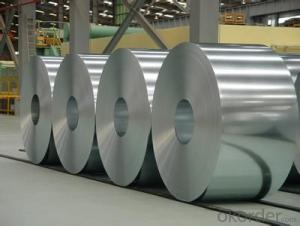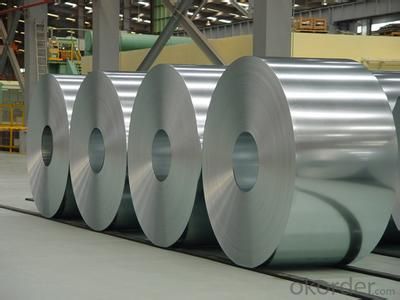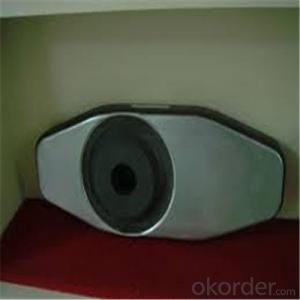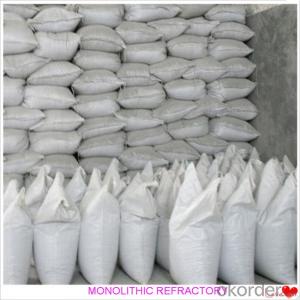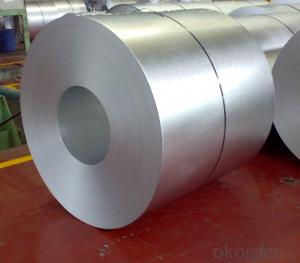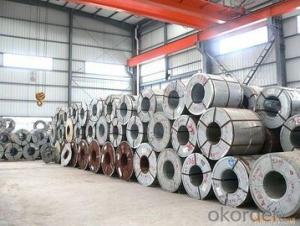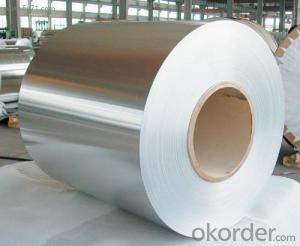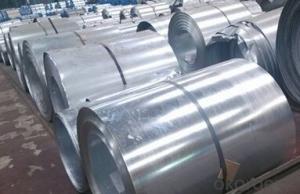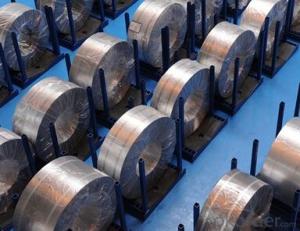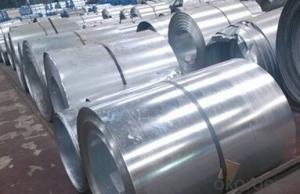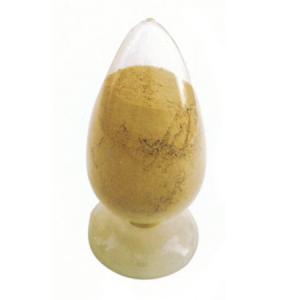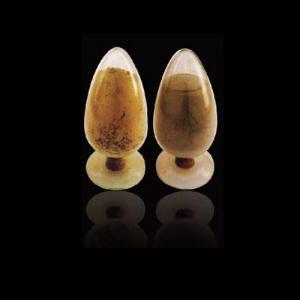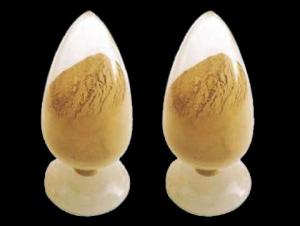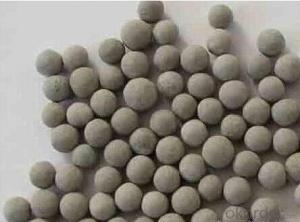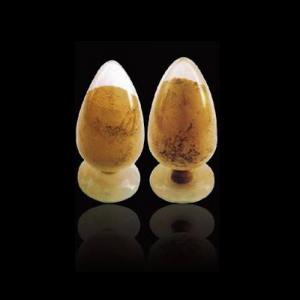Monolithic Refractories Hot-Dip Aluzinc Steel Building Roof Walls in Best Price Best Quality
- Loading Port:
- China main port
- Payment Terms:
- TT or LC
- Min Order Qty:
- 50 m.t.
- Supply Capability:
- 10000 m.t./month
OKorder Service Pledge
OKorder Financial Service
You Might Also Like
Hot-dip Aluzinc Steel Building Roof Walls in Best Price Best Quality
1. Description of the Hot-dip Aluzinc Steel:
Hot-dip aluzinc steel structure is composed of aluminum-zinc alloy, consisting of 55% aluminum, 43% zinc and 2% at 600 ℃ silicon solidification temperature and composition, the entire structure is made of aluminum - iron - silicon - zinc, to form a dense quaternary crystals an alloy.
Hot-dip aluzinc steel has many excellent features: strong corrosion resistance, is three times the pure galvanized sheet; zinc surface with beautiful flowers, can be used as a building outside board.
Applications of hot-dip aluzinc steel:
1)Building: roof, walls, garages, soundproof walls, pipes and modular housing.
2)Automotive: muffler, exhaust pipes, wiper accessories, fuel tank, truck boxes, etc.
3)Appliances: refrigerator back, gas stove, air conditioners, microwave oven, LCD frame, 4)CRT-proof band, LED backlight, electrical cabinets, etc.
5)Farm: barn, sheds, silos, piping and other greenhouse.
2.Main Features of the Hot-dip Aluzinc Steel:
• Excellent corrosion resistance
• High temperature oxidation resistance
• Good manufacturability
•Beautiful appearance
•Surface coating
•Cost-effective
3.Hot-dip Aluzinc Steel Images
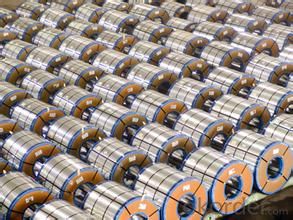
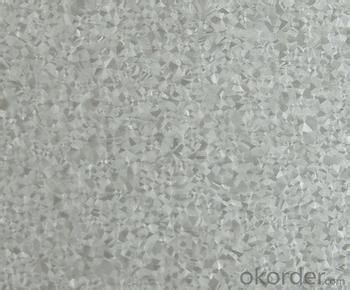
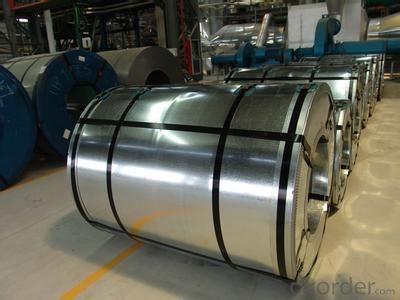
4.Hot-dip Aluzinc Steel Specification
AVAILABLE SPECIFICATION
HOT-DIP ALUZINC STEEL COILS | |
THICKNESS | 0.16mm-3.5mm |
WIDTH | 1250mm MAX |
COATING MASS | 30g/ m2-185 g/ m2 |
SPANGLE | Regular Spangle, Minimized Spangle, Zero Spangle |
SURFACE TREATMENT | Chromated / non-chromated, Oiled / non-oiled, Anti Finger Print |
COIL INNER DIAMETER | 508mm or 610mm |
HOT-DIP ALUZINC STEEL COILS | |||
COMMERCIAL QUALITY | ASTM A792M-06a | EN10327-2004 | JIS G 3321:2010 |
STRUCTURE STEEL | SS GRADE 230 SS GRADE 255 SS GRADE 275 SS GRADE 340 SS GRADE 550 | S220GD+AZ S250GD+AZ S280GD+AZ S320GD+AZ S350GD+AZ S550GD+AZ | SGLC400 SGLC440 SGLC490 SGLC570 |
5.FAQ of Hot-dip Aluzinc Steel
We have organized several common questions for our clients,may help you sincerely:
1.What advantages does your company have?
Cement : Annual capacity of 400 million tons, No. 1 in the world
Fiberglass: Annual capacity of 1 million tons fiberglass, No. 1 in the world.
Composite Materials — Rotor Blade: Annual production capacity of 15,000 pieces, No.1 in China, Top3 worldwide
Light Weight Building Materials: Annual capacity of 1.65 billion square meters of gypsum board, No. 1 in the world.
Commercial concrete: Annual capacity of 0.35 billion cubic meters, No. 1 in the world.
Refractory Material: Annual capacity of 40,000 tons casting refractory, No.1 in the world.
2.What advantages do your products have?
Firstly, our base material is of high quality, Their performance is in smooth and flat surface,no edge wave ,good flexibility.
Secondly, high quality zinc ingoats, 97.5% zinc,1.5% silicon,1% others, the same zinc coating measured by metal coating thickness or by zinc weight
Thirdly, high precision: Tolerance strictly according to ASTM or JISG standard even more rigid.
We have full stes of testing equipment(for t best, cupule,chromatism,salt spray resistance, etc) and professional engineers.
- Q: What are the key trends in the use of monolithic refractories in the iron and steel industry?
- It is worth noting that there are several notable trends in the use of monolithic refractories in the iron and steel industry. First and foremost, there is an increasing demand for monolithic refractories due to their superior performance characteristics in comparison to traditional brick refractories. Monolithic refractories provide higher thermal shock resistance, superior insulation properties, and improved resistance to chemical attacks. As a result, they are being used more extensively in various applications within the iron and steel industry. Secondly, there is a shift towards the utilization of low-cement and ultra-low cement castables in monolithic refractories. These materials contain a reduced amount of cement, leading to enhanced refractory properties such as increased strength, better corrosion resistance, and improved resistance to thermal spalling. This trend is driven by the need to enhance the overall efficiency and longevity of refractory linings in iron and steel manufacturing processes. Another significant trend is the development of advanced monolithic refractories that prioritize sustainability and environmental performance. The iron and steel industry is facing mounting pressure to reduce its carbon footprint and minimize its impact on the environment. Consequently, there is a growing emphasis on the use of environmentally friendly binders and additives in monolithic refractories. These novel materials not only offer excellent refractory properties but also contribute to the industry's sustainability objectives. Moreover, there is an increasing focus on the development of monolithic refractories capable of withstanding extreme operating conditions. Iron and steel manufacturing processes involve high temperatures, aggressive chemical environments, and severe mechanical stresses. Consequently, there is a need for monolithic refractories that can withstand these harsh conditions without compromising their performance. The industry is investing in research and development to create refractories that exhibit exceptional resistance to thermal shock, abrasion, and erosion. Lastly, there is a growing adoption of digital and smart technologies for the monitoring and maintenance of monolithic refractories. Advances in sensor technology and data analytics have made it possible to collect real-time data on the condition and performance of refractory linings. This enables proactive maintenance, early detection of potential issues, and optimization of refractory usage, ultimately leading to improved operational efficiency and cost savings. In conclusion, the use of monolithic refractories in the iron and steel industry is witnessing key trends such as the demand for superior performance, the shift towards low-cement and ultra-low cement castables, the development of sustainable materials, the focus on extreme operating conditions, and the adoption of digital and smart technologies for monitoring and maintenance. These trends reflect the industry's continuous efforts to enhance the efficiency, durability, and environmental sustainability of refractory linings in iron and steel manufacturing processes.
- Q: How do monolithic refractories contribute to the overall efficiency of ladle refining processes?
- Monolithic refractories play a crucial role in enhancing the overall efficiency of ladle refining processes. Ladle refining is a critical step in steelmaking, where impurities are removed and alloying elements are added to achieve the desired steel properties. Monolithic refractories, which are unshaped refractory materials, offer several benefits that contribute to the efficiency of this process. Firstly, monolithic refractories provide excellent thermal insulation. Ladle refining processes involve high temperatures, and the refractories' ability to withstand and contain these temperatures is vital. Monolithic refractories have low thermal conductivity, which minimizes heat loss from the ladle. This insulation helps maintain the desired temperature within the ladle, allowing for efficient refining and reducing the energy required for heating. Secondly, monolithic refractories have high resistance to chemical attack and erosion. During ladle refining, the steel is exposed to various chemical reactions and corrosive elements. Monolithic refractories are designed to withstand these harsh conditions, protecting the ladle from chemical attack and erosion. This resistance ensures that the refractories maintain their structural integrity, preventing any contamination of the steel and extending the lifespan of the ladle. Moreover, monolithic refractories offer easy installation and repair. Unlike traditional brick refractories, monolithic refractories can be applied as a single, homogeneous layer, eliminating the need for complex bricklaying techniques. This ease of installation reduces downtime during ladle maintenance and repair, improving the overall efficiency of the refining process. Additionally, monolithic refractories can be easily patched or repaired as needed, further reducing downtime and ensuring continuous operation. In conclusion, monolithic refractories contribute significantly to the overall efficiency of ladle refining processes. Their exceptional thermal insulation properties, resistance to chemical attack and erosion, and ease of installation and repair all play a vital role in enhancing the efficiency and productivity of ladle refining. By providing a reliable and durable lining for the ladle, monolithic refractories help maintain the desired temperature, prevent contamination, and minimize downtime, ultimately improving the quality and yield of the refined steel.
- Q: What are the main applications of monolithic refractories in the iron and steel industry?
- Monolithic refractories are widely used in the iron and steel industry for various applications such as lining furnaces, ladles, and tundishes. They provide excellent thermal insulation, high resistance to thermal shock, and resistance to chemical reactions with molten metal. These refractories help in maintaining consistent temperature and reducing heat loss, thereby ensuring efficient and cost-effective production processes in the iron and steel industry.
- Q: What types of monolithic refractories are commonly used in the iron and steel industry?
- Due to their exceptional resistance to extreme temperatures and mechanical stresses, various types of monolithic refractories are widely used in the iron and steel industry. These refractories play a crucial role in lining furnaces, ladles, and other equipment used in the production of iron and steel. One commonly employed monolithic refractory in this industry is castable refractory. It is a blend of refractory aggregates, binders, and additives that can be poured or cast into different shapes and sizes. Castable refractories are versatile and easy to install, making them suitable for lining large furnaces and ladles. Additionally, they offer excellent resistance to thermal shocks and provide good thermal insulation. Another type of monolithic refractory utilized in the iron and steel industry is plastic refractory. It comprises a high-alumina refractory aggregate mixed with a bonding agent, typically clay. Plastic refractories possess high plasticity and can be easily shaped by hand or with a trowel. They are commonly used for repairing and patching in furnaces and ladles. Ramming refractories are also frequently employed in the iron and steel industry. These refractories consist of granular refractory materials blended with a binder. They are installed by forcefully ramming the mixture into the desired shape using either a pneumatic hammer or manual ramming tools. Ramming refractories offer exceptional resistance to abrasion and erosion, making them suitable for lining the bottoms of furnaces and other areas subjected to intense mechanical wear. Lastly, gunning refractories find wide application in the iron and steel industry. Gunning refractories are composed of fine refractory powders mixed with water or a bonding agent. They are applied using a gunning machine, which propels the refractory material onto the surface that requires lining. Gunning refractories are commonly used for repairing and maintaining the linings of ladles, tundishes, and other equipment. In conclusion, the iron and steel industry heavily relies on a variety of monolithic refractories, including castables, plastics, rammings, and gunnings, to ensure the reliable and efficient operation of their equipment in high-temperature environments. These refractories offer outstanding thermal insulation, resistance to thermal shocks, and mechanical strength, which are essential for the production of iron and steel.
- Q: How do monolithic refractories contribute to energy efficiency in the iron and steel industry?
- Monolithic refractories play a crucial role in enhancing energy efficiency in the iron and steel industry through various mechanisms. Firstly, these materials have excellent thermal insulation properties, which helps in minimizing heat loss from the furnaces and other high-temperature equipment. By reducing heat loss, monolithic refractories ensure that the heat generated during the iron and steel production process is efficiently utilized, leading to significant energy savings. Furthermore, monolithic refractories exhibit superior thermal shock resistance, allowing them to withstand rapid temperature changes without cracking or spalling. This property is particularly important in the iron and steel industry, where the furnaces and other equipment are subjected to extreme temperature variations. By maintaining structural integrity even under such conditions, monolithic refractories prevent heat leakage and ensure that the energy input is effectively utilized. Moreover, these refractories also contribute to energy efficiency by reducing downtime and improving operational efficiency. Monolithic refractories are known for their easy installation and repair, resulting in shorter maintenance and repair cycles. This minimizes the downtime required for furnace maintenance, allowing for continuous operation and uninterrupted energy utilization. Additionally, the high durability of monolithic refractories reduces the need for frequent replacements, further enhancing energy efficiency by reducing material and energy waste associated with regular repairs. In conclusion, monolithic refractories significantly contribute to energy efficiency in the iron and steel industry by minimizing heat loss, withstanding thermal shocks, and reducing downtime. These materials ensure that the energy input in the production process is effectively utilized, resulting in substantial energy savings and improved operational efficiency.
- Q: How are monolithic refractories installed and repaired in iron and steel applications?
- Monolithic refractories are installed and repaired in iron and steel applications using specific procedures to ensure optimal performance and longevity. The installation process typically involves the following steps: 1. Surface preparation: The surface where the monolithic refractory will be installed needs to be properly cleaned and prepared. This includes removing any loose material, dirt, and dust. It is crucial to have a smooth and clean substrate to ensure good adherence of the refractory material. 2. Mixing the refractory material: Monolithic refractories are typically supplied as dry powders or granules that need to be mixed with water or a specific bonding agent to form a workable consistency. The mixing process should be done according to the manufacturer's instructions to achieve the desired properties of the refractory. 3. Application: The mixed refractory material is then applied to the prepared surface using various techniques such as troweling, spraying, or casting. The choice of application method depends on the specific requirements of the installation and the type of monolithic refractory being used. 4. Curing: After the refractory material is applied, it needs to be properly cured to achieve its maximum strength and durability. Curing can be done by air drying, using heat, or a combination of both, depending on the specific refractory material being used. The curing process should be carried out gradually and according to the manufacturer's recommendations. When it comes to repairs of monolithic refractories in iron and steel applications, the following steps are generally followed: 1. Assessment: The damaged area or component needs to be thoroughly assessed to determine the extent of the damage and the appropriate repair method. 2. Removal of damaged material: The damaged monolithic refractory material is carefully removed using appropriate tools and techniques. It is important to remove all the damaged material while ensuring that the underlying substrate is not further compromised. 3. Surface preparation: Similar to the installation process, the surface where the repair will be carried out needs to be properly cleaned and prepared. Any loose material, dirt, and dust should be removed to create a clean and smooth substrate. 4. Application of repair material: The repair material, which is typically the same or similar to the original monolithic refractory, is mixed and applied to the damaged area. The application method may vary depending on the nature of the repair and the specific requirements of the refractory material. 5. Curing and post-repair inspection: The repaired area should be properly cured and inspected to ensure the quality and effectiveness of the repair. Curing and inspection procedures should adhere to the manufacturer's guidelines. In summary, the installation and repair of monolithic refractories in iron and steel applications require careful surface preparation, proper mixing and application of the refractory material, and appropriate curing procedures. Following these steps in a meticulous manner ensures reliable and durable refractory linings, which are essential for the efficient operation of iron and steel processes.
- Q: What are the factors affecting the thermal expansion of monolithic refractories?
- The factors affecting the thermal expansion of monolithic refractories are the composition of the refractory material, the temperature gradient, and the firing or curing process.
- Q: What are the specific requirements of monolithic refractories for ladle purging applications?
- The specific requirements of monolithic refractories for ladle purging applications include high thermal shock resistance, excellent erosion resistance, good slag resistance, and low porosity. Thermal shock resistance is crucial in ladle purging applications as the refractory material needs to withstand rapid temperature changes without cracking or spalling. This is particularly important during ladle purging, where the ladle is exposed to high temperatures during molten metal pouring and then quickly cooled down during purging. Erosion resistance is another important requirement for monolithic refractories in ladle purging applications. The refractory material should be able to withstand the erosive action of molten metal streams and metalloids during purging. It should have a high resistance to chemical attack, preventing the material from deteriorating or eroding away. Slag resistance is also necessary for monolithic refractories used in ladle purging. The refractory material should have good resistance to the corrosive effects of slag, which can be present in ladles during purging. Slag can cause chemical reactions that can degrade the refractory material, leading to premature failure. Low porosity is an essential requirement for monolithic refractories in ladle purging applications. Low porosity ensures that the refractory material is impermeable to molten metal, preventing it from infiltrating the material and causing damage. This also helps to maintain the integrity and performance of the refractory lining during ladle purging. Overall, monolithic refractories for ladle purging applications need to exhibit high thermal shock resistance, excellent erosion resistance, good slag resistance, and low porosity to ensure the durability and longevity of the refractory lining in ladles during purging operations.
- Q: How do monolithic refractories improve the efficiency of ladle and tundish preheaters?
- Monolithic refractories improve the efficiency of ladle and tundish preheaters by providing excellent insulation, high thermal conductivity, and resistance to thermal shock. These properties allow for better heat retention, reduced heat loss, and quicker and more uniform heating of the ladle and tundish, ultimately improving the overall efficiency of the preheating process.
- Q: How do monolithic refractories improve the efficiency of ladle and tundish drying furnaces?
- Monolithic refractories improve the efficiency of ladle and tundish drying furnaces by providing excellent thermal insulation, high resistance to thermal shock, and superior strength. These properties ensure minimal heat loss during the drying process, allowing for faster and more efficient heating. Additionally, monolithic refractories offer better resistance to erosion and corrosion, prolonging the lifespan of the furnaces and reducing maintenance requirements. Overall, the use of monolithic refractories enhances the performance and productivity of ladle and tundish drying furnaces.
Send your message to us
Monolithic Refractories Hot-Dip Aluzinc Steel Building Roof Walls in Best Price Best Quality
- Loading Port:
- China main port
- Payment Terms:
- TT or LC
- Min Order Qty:
- 50 m.t.
- Supply Capability:
- 10000 m.t./month
OKorder Service Pledge
OKorder Financial Service
Similar products
Hot products
Hot Searches
Related keywords
